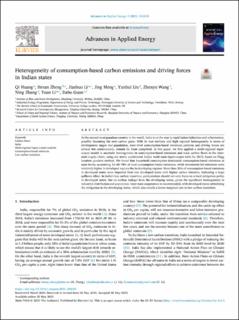| dc.description.abstract | As the second most populous country in the world, India is on the way to rapid industrialization and urbanization, possibly becoming the next carbon giant. With its vast territory and high regional heterogeneity in terms of development stages and population, state-level consumption-based emissions patterns and driving forces are critical but unfortunately, remain far from completed. In this paper, we first applied a multi-regional input-output model to ascertain heterogeneity in consumption-based emissions and track carbon flows in the inter-state supply chain, using our newly constructed Indian multi-state input-output table for 2015, based on Flegg location quotient method. We found that household consumption dominated consumption-based emissions at state levels, accounting for 60–78% of total consumption-based emissions, while investment-led emissions were relatively higher in developed regions the in developing regions. More than 30% of consumption-based emissions in developed states were imported from less developed states with higher carbon intensity, indicating a large spillover effect. In India's low carbon transition, policymakers should not only focus on a local mitigation policy in developed states, but on carbon leakage from the developing states, given the significant heterogeneity in industrial distribution and population. Inter-state cooperation is recommended, with developed states subsidizing the mitigation in the developing states, which also entails a lower marginal cost to low carbon transition. | en_US |

